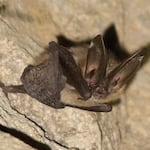
Bureau of Land Management wildlife technician photographed William ShakespEAR, a female Townsend's big-eared bat, in Jackson County. William ShakespEAR won BLM's 2023 Bat Beauty Contest.
Photo courtesy Emma Busk / Bureau of Land Management
Is Oregon home to the most beautiful bats? If the national Bat Beauty Contest is any indicator, it might be.
An Oregon bat won the annual photo contest organized by the Bureau of Land Management for the second year in a row. This time, the prize went to William ShakespEAR, a bat from Butte Falls in Jackson County.
William ShakespEAR, a female Townsend’s big-eared bat, was photographed by BLM wildlife technician Emma Busk.
Last year, the crown went to Barbara, a canyon bat from Lake County that was photographed by Alyson Yates, a BLM volunteer and bat photographer.
The federal lands agency hosts the bat beauty contest every year, accepting photos of bats taken on public lands across the country. The event begins on Oct. 24 and ends on Halloween, coinciding with International Bat Week, to raise awareness about bat conservation.
While bats might have a bad reputation — being a little creepy at best and rabies carriers at worst — they play an important role in keeping pests down, including mosquitos, beetles and moths. A single bat can eat up to 1,200 mosquitos in an hour, according to BLM.
“There are a lot of myths around bats, but they’re amazing wildlife and they contribute so much to our ecosystem,” Busk said in a statement.
Busk photographed William ShakespEAR last year in Jackson County, home of the Oregon Shakespeare Festival, while monitoring a bat colony. Townsend’s big-eared bats are known for forming maternity colonies in the spring before they have their pups.
These bats require open space where they can roost in caves, Busk said. Biologists carefully monitor their populations to check for illnesses that could harm their numbers, including white-nose syndrome, which can kill hibernating bats.
---
Editor’s note: This article has been corrected to show that last year’s winning photo was taken by Alyson Yates, a BLM volunteer and bat photographer.
